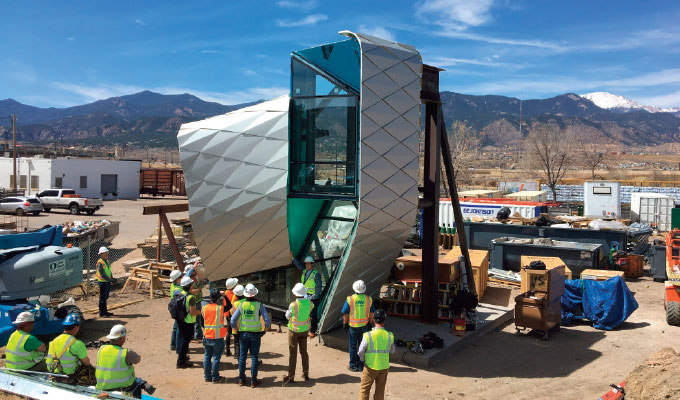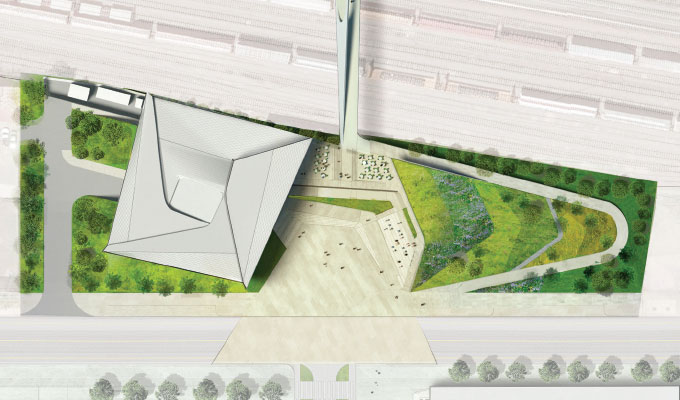United States Olympic Museum in Colorado Springs, Colorado
Leaving a legacy often requires a lifelong fortitude of purpose and character that only the best among us can realize regardless of pursuit. In athletics, the pinnacle of success is that of an Olympic gold medalist, a champion among all of mankind. In construction and design, legacies may not be as easily quantified but once the truly spectacular is achieved it’s hard to overlook. When the new United States Olympic Museum in Colorado Springs, Colorado, opens to the public, it will unmistakably add to the legacies of design architects Diller Scofidio + Renfro (DS+R) and General Contractor/Construction Manager GE Johnson Construction Company.
“The incredible architecture we are delivering is challenging all of us to think beyond boundaries,” says GE Johnson superintendent, Tim Redfern, an industry veteran of more than 25 years. Redfern and GE Johnson Construction’s team are tasked with assembling a structure unlike any other ever built.
MOTION INSPIRATION
DS+R’s design for the U.S. Olympic Museum takes its athletes as inspiration; the design idealizes athletic motion by organizing its programs—galleries, auditorium, and administrative spaces—twisting and stretching centrifugally around an atrium space.
“The dynamic building form defies typical construction. Thinking outside of the box is not an adequate description of what we’re doing to make this happen,” shares Redfern. The design’s diverse elevations called for 15 independent concrete slab-on-metal deck elevations, scaling just four stories of construction with no two planes running parallel for long. Structural tolerances are ultra-tight, becoming even less forgiving as the structure goes up—the opposite of most builds. The exterior frame tolerance is 2 inches, while interior frame tolerances are only a quarter of an inch, with just an eighth of an inch of deflection. Controlling precise placement of every piece of an exceptionally intricate puzzle like the United States Olympic Museum is a process that can only be accomplished through what GE Johnson thinks of as a spirit of continuous improvement.
“Normally, once you have things figured out, construction becomes routine,” says project manager, John McCorkle. “I don’t see that happening here. We’re continually questioning how we do things. The ingenuity of this structure demands constant collaboration with designers, builders, fabricators, and installers. Everyone will be learning all the way until the end.”
PRECISION IN THE CLOUD
GE Johnson is pre-thinking and rethinking every move by incorporating a 3D point cloud that provides an accurate digital record of physically intangible space. All subcontractors are required to use the point cloud to develop approvable shop drawings. The point cloud is integrated with the BIM model, which draws from several computer-aided design, graphics, engineering, and manufacturing programs, along with the discipline-specific platforms of a variety of different subcontractors. Integrated work plans developed with subcontractors define every aspect of each construction activity including who, what, when, and where. Most importantly, plans will detail how each piece is assembled, verified, and validated for accuracy against the overall model as tasks complete. Looking beyond typical clash detection, GE Johnson’s fully detailed steel fabrication model allows the clearances of each structural framing member to be independently checked to make sure the design’s distinctive shell of diverging planes and scaled metal skin reads as intended.
The museum’s unique exterior skin aptly illustrates the intricate precision of purpose and combination of expertise required to succeed at the Olympic level. The facade will be covered in more than 9,000 individual diamond-shaped anodized aluminum petals that interlock to form a single, beveled surface with integrated drainage channels. In total, an estimated 27,000 anchor points will attach the exterior wall sections to the structural frame. The specific details of every panel from backing materials, sheathing, and waterproofing will all be independently analyzed within the model because seemingly every petal is either uniquely shaped, placed, or attached.
“Premium-quality construction is always a collaboration,” says McCorkle. “Delivering this design uncompromised means getting out of the comfort zone and seeking capabilities beyond our own.” Early in the problem-solving process GE Johnson worked with design architect DS+R, architect of record Anderson Mason Dale, and structural engineer KL&A on refining the micro-framing system that attaches exterior wall sections to the structure. To address the complex sub-framing of the skin, through a design-assist collaboration, GE Johnson and the team decided to work with Radius Track, renowned for developing curved, cold-formed steel framing, to develop a buildable system. Through continual collaboration, the team was able to optimize wind-girt supports, which increased certainty and repeatability in installation while also decreasing costs overall.

20-foot x 20-foot full-scale exterior wall section erected on-site
ACCURATE ALIGNMENT
Even as the structure reaches its highest elevation, preconstruction activities continue. For the specialized subcontractors developing a sequence of efficiently attaching the exterior skin to the structure, nothing is more valuable than the full-scale exterior wall section being erected on-site. McCorkle and Redfern estimate that the 20-foot x 20-foot mockup wall section will require more than 1,000 labor hours to assemble and will likely cost in excess of $150,000 to build. Eight different subcontractors must delicately interlace their work through a maze of structural framing, light-gauge framing, waterproofing, drainage, glazing, and aluminum panels. Identifying components within wall sections that can be prefabricated off-site, like the micro-framing system and laser cutting framing plates, increases quality control and supports repeatable processes during construction. Each component is individually numbered indicating where, how, and to what it attaches like a giant model and each placement can be checked against the point cloud to verify accurate alignment.
“We have been empowered to use ingenuity to solve complex challenges at every turn on a very, very cool building,” finishes Redfern. “GE Johnson is using anything and everything we can to build this right. Pushing boundaries, gaining outside expertise, and asking more of oneself than others will is the Olympic spirit this museum is being built to honor.”
ABOUT THE AUTHOR
Sean O’Keefe has more than 18 years of experience articulating the complexities, challenges, and camaraderie of construction and design. He writes Built Environment stories for owners, architects, contractors, and product manufacturers and can be reached at sean@sokpr.com.
____________________________________________________________________
Modern Contractor Solutions, October 2018
Did you enjoy this article?
Subscribe to the FREE Digital Edition of Modern Contractor Solutions magazine.



